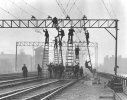By the time you've lugged half a dozen substations on to the top of the Pennines, then added in resistive losses and the much greater likelihood of delay, and you've probably not saved yourself an awful lot. 25KV OLE with batteries would get rid of diesel on the TPE routes by 2030, making it much less important to wire the entire route in one go. Then there's also the issue of current draw, if we ever want electric freight on this line.At the risk of getting shot down in flames...
If routes like the current TPE Leeds - Manchester route (mainly 75mph max, with scope to increase to maybe 90mph but not much further), how much cheaper and quicker would a side or bottom contact protected 3rd rail at say 1200v DC be to install. Multi voltage stock is now commonplace, the DC buses and motors tend to work at these sort of voltages anyway, no bridges to raise, no catenary to thread through tunnels, station canopies to alter, a whole lot of work is no longer required. Gapping can be addressed with a small supercaptitor power pack. 3rd rail can do 90-100mph, none of the existing route is good for mare than that. Installation could very simple taking advantage of short nightime periods. Containerised feeder stations. Might not be the gold atandard, but I am sure you could progress a lot quicker, at far less cost. After all the L&Y did side contact 1200v DC over 100 years ago.
Judging by current progress trains between Leeds and Manchester will still be diesel in 2040. We need to find a way to deliver cost effective improvements. And remember once you have done Standedge route you really need to do Calder Valley
If you ever get a new 'high speed route' between Leeds and Manchester that will be 25kV OHL but I think given the challenges and costs currently its pie in the sky. and if it ever does get built the 3rd rail would probably be due for renewal by then, so maybe revisit if its worth going to 25kV OHL, but by that point it would be local services only and the need may not be there to upgrade, just replace like for like, as the current barriers will still be there.
If you were wanting a cheaper option something like 3KV DC OLE might be worth exploring - it's a mature technology used in Germany and France, it's a high enough voltage that the resistance is low but shouldn't need as much clearance work. But a key advantage of the system we have at the moment is commonality. Trains can be simpler, supply chains are smoother, emergency parts can be got from neighbouring depots, skills and knowledge are transferrable around the country etc, etc. Having a bespoke system breaks that down and introduces hidden costs.



